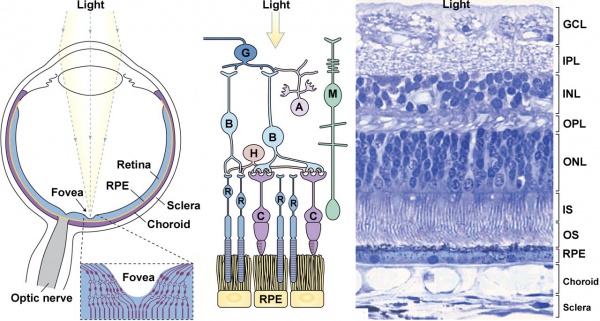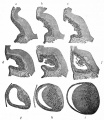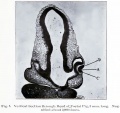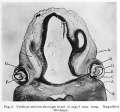Vision - Cornea Development: Difference between revisions
(Created page with "{{Header}} ==Introduction== right|300px These notes introduce the development of the eye cornea. {{Vision Links}} {{Senses Links}} ==...") |
mNo edit summary |
||
| Line 1: | Line 1: | ||
{{Header}} | {{Header}} | ||
==Introduction== | ==Introduction== | ||
These notes introduce the development of the cornea of the eye. | |||
These notes introduce the development of the eye | |||
{{Vision Links}} | {{Vision Links}} | ||
[[Integumentary Development]] | |||
== Some Recent Findings == | |||
{| | {| | ||
|-bgcolor="F5FAFF" | |-bgcolor="F5FAFF" | ||
| | | | ||
* | * <ref name = PMID><pubmed>22496813</pubmed></ref> | ||
|} | |} | ||
{| class="wikitable mw-collapsible mw-collapsed" | {| class="wikitable mw-collapsible mw-collapsed" | ||
| Line 25: | Line 19: | ||
| [[File:Mark_Hill.jpg|90px|left]] {{Most_Recent_Refs}} | | [[File:Mark_Hill.jpg|90px|left]] {{Most_Recent_Refs}} | ||
Search term: '' | Search term: [http://www.ncbi.nlm.nih.gov/pubmed/?term=Cornea+Development ''Cornea Development''] | ||
<pubmed limit=5> | <pubmed limit=5>Cornea Development</pubmed> | ||
Search term: [http://www.ncbi.nlm.nih.gov/pubmed/?term=Cornea+Embryology ''Cornea Embryology''] | |||
<pubmed limit=5>Cornea Embryology</pubmed> | |||
|} | |} | ||
==Timeline== | ==Timeline== | ||
| Line 56: | Line 54: | ||
* [[Carnegie_stage_23|Stage 23]] - The retina comprises the pigmented layer, external limiting membrane, proliferative zone, external neuroblastic layer, transient fiber layer, internal neuroblastic layer, nerve fiber layer, and internal limiting membrane. Eyelids closure is complete (Note - shown as still open in the Kyoto embryo). | * [[Carnegie_stage_23|Stage 23]] - The retina comprises the pigmented layer, external limiting membrane, proliferative zone, external neuroblastic layer, transient fiber layer, internal neuroblastic layer, nerve fiber layer, and internal limiting membrane. Eyelids closure is complete (Note - shown as still open in the Kyoto embryo). | ||
== | ==Frog Cornea== | ||
This developmental timeline is from a recent Xenopus laevis cornea study<ref name=PMID23896054><pubmed>23896054</pubmed>| [http://www.sciencedirect.com/science/article/pii/S0014483513002194 Exp Eye Res.]</ref> | |||
* '''stage 25''' - cornea starts from a simple embryonic epidermis overlying the developing optic vesicle. | |||
* '''stage 30''' - detachment of the lens placode, cranial neural crest cells start to invade the space between the lens and the embryonic epidermis to construct the corneal endothelium. | |||
* '''stage 41''' - a second wave of migratory cells containing presumptive keratocytes invades the matrix leading to the formation of inner cornea and outer cornea. A unique cell mass (stroma attracting center) connects the two layers like the center pole of a tent. | |||
* '''stage 48''' - many secondary stromal keratocytes individually migrate to the center and form the stroma layer. | |||
* '''stage 60''' - the stroma space is filled by collagen lamellae and keratocytes, and the stroma attracting center disappears. At early metamorphosis, the embryonic epithelium gradually changes to the adult corneal epithelium, which is covered by microvilli. | |||
* '''stage 62''' - the embryonic epithelium thickens and cell death is observed in the epithelium, coinciding with eyelid opening. | |||
* '''After metamorphosis''' - cornea has attained the adult structure of three cellular layers, epithelium, stroma, and endothelium, and between the cellular layers lie two acellular layers (Bowman's layer and Descemet's membrane) | |||
:'''Links:''' [[Frog Development]] | |||
==Additional Images== | ==Additional Images== | ||
<gallery> | <gallery> | ||
</gallery> | </gallery> | ||
===Historic Images=== | ===Historic Images=== | ||
<gallery> | <gallery> | ||
File:Bailey463.jpg|Fig. 463. Developing lens and optic cup. | File:Bailey463.jpg|Fig. 463. Developing lens and optic cup. | ||
File:Bailey464.jpg|Fig. 464. Model showing lens and formation of optic cup. | File:Bailey464.jpg|Fig. 464. Model showing lens and formation of optic cup. | ||
| Line 141: | Line 80: | ||
File:Bailey466.jpg|Fig. 466. Section through optic cup and lens invagination of chick of fifty-four hours' incubation. | File:Bailey466.jpg|Fig. 466. Section through optic cup and lens invagination of chick of fifty-four hours' incubation. | ||
File:Bailey467.jpg|Fig. 467. Section through eye of human embryo of 13-14 weeks. | File:Bailey467.jpg|Fig. 467. Section through eye of human embryo of 13-14 weeks. | ||
File:Brown001.jpg|Fig. 1. Section through head of pig, 2 mm long. | File:Brown001.jpg|Fig. 1. Section through head of pig, 2 mm long. | ||
File:Brown002.jpg|Fig. 2. Section through head of chick, 2 mm long. | File:Brown002.jpg|Fig. 2. Section through head of chick, 2 mm long. | ||
| Line 154: | Line 90: | ||
File:Brown009.jpg|Fig. 9. Section through head of pig, 9 mm long. | File:Brown009.jpg|Fig. 9. Section through head of pig, 9 mm long. | ||
File:Brown010.jpg | File:Brown010.jpg | ||
</gallery> | </gallery> | ||
| Line 160: | Line 95: | ||
<references/> | <references/> | ||
===Reviews=== | ===Reviews=== | ||
| Line 185: | Line 106: | ||
'''Bookshelf''' [http://www.ncbi.nlm.nih.gov/sites/entrez?db=Books&cmd=search&term= | '''Bookshelf''' [http://www.ncbi.nlm.nih.gov/sites/entrez?db=Books&cmd=search&term=cornea%20development cornea development] | ||
===Search Pubmed=== | ===Search Pubmed=== | ||
'''Search Pubmed:''' [http://www.ncbi.nlm.nih.gov/pubmed?term= | '''Search Pubmed:''' [http://www.ncbi.nlm.nih.gov/pubmed?term=cornea%20development cornea development] | ||
'''Search Entrez:''' [http://www.ncbi.nlm.nih.gov/sites/gquery?itool=toolbar&cmd=search&term= | '''Search Entrez:''' [http://www.ncbi.nlm.nih.gov/sites/gquery?itool=toolbar&cmd=search&term=cornea%20development cornea development] | ||
==Terms== | ==Terms== | ||
Revision as of 11:12, 30 August 2014
| Embryology - 25 Apr 2024 |
|---|
| Google Translate - select your language from the list shown below (this will open a new external page) |
|
العربية | català | 中文 | 中國傳統的 | français | Deutsche | עִברִית | हिंदी | bahasa Indonesia | italiano | 日本語 | 한국어 | မြန်မာ | Pilipino | Polskie | português | ਪੰਜਾਬੀ ਦੇ | Română | русский | Español | Swahili | Svensk | ไทย | Türkçe | اردو | ייִדיש | Tiếng Việt These external translations are automated and may not be accurate. (More? About Translations) |
Introduction
These notes introduce the development of the cornea of the eye.
Some Recent Findings
| More recent papers |
|---|
|
This table allows an automated computer search of the external PubMed database using the listed "Search term" text link.
More? References | Discussion Page | Journal Searches | 2019 References | 2020 References Search term: Cornea Development <pubmed limit=5>Cornea Development</pubmed> Search term: Cornea Embryology <pubmed limit=5>Cornea Embryology</pubmed> |
Timeline
|
Embryonic Development
|

|
Carnegie Stages - Eye
The following data is from a study of human embryonic carnegie stages[2] and other sources.
- Stage 10 - optic primordia appear.
- Stage 11 - right and left optic primordia meet at the optic chiasma forming a U-shaped rim.
- Stage 12 - optic neural crest reaches its maximum extent and the optic vesicle becomes covered by a complete sheath,
- Stage 13 - By the end of the fourth week the optic vesicle lies close to the surface ectoderm. Optic evagination differentiation allows identification of optic part of retina, future pigmented layer of retina, and optic stalk. The surface ectoderm overlying the optic vesicle, in response to this contact, has thickened to form the lense placode.
- Stage 14 - (about 32 days) the lens placode is indented by the lens pit, cup-shaped and still communicates with the surface by a narrowing pore.
- Stage 15 - (about 33 days) the lens pit is closed. The lens vesicle and optic cup lie close to the surface ectoderm and appear to press against the surface.
- Stage 16 - (37 days) Growth of the lens body results in a D-shaped lens cavity. Perilental blood vessels (tunica vasculosa lentis) are visible. Prior to the development of the eyelids, one small sulcus or groove forms above the eye (eyelid groove) and another below it.
- Stages 17 - 19 - Retinal pigment is visible and the retinal fissure is largely closed. Eyelids grooves deepen, eyelid folds develop, first below, and then above, the eye.
- Stages 18 - Mesenchyme invades the region between the lens epithelium and the surface ectoderm.
- Stages 19 - 22 - the eyelid folds develop into the eyelids and cover more of the eye as the palpebral fissure takes shape. The upper and the lower eyelids meet at the outer canthus in Stage 19.
- Stage 20 - The lens cavity is lost and a lens suture begins to form. The inner canthus is established.
- Stage 23 - The retina comprises the pigmented layer, external limiting membrane, proliferative zone, external neuroblastic layer, transient fiber layer, internal neuroblastic layer, nerve fiber layer, and internal limiting membrane. Eyelids closure is complete (Note - shown as still open in the Kyoto embryo).
Frog Cornea
This developmental timeline is from a recent Xenopus laevis cornea study[3]
- stage 25 - cornea starts from a simple embryonic epidermis overlying the developing optic vesicle.
- stage 30 - detachment of the lens placode, cranial neural crest cells start to invade the space between the lens and the embryonic epidermis to construct the corneal endothelium.
- stage 41 - a second wave of migratory cells containing presumptive keratocytes invades the matrix leading to the formation of inner cornea and outer cornea. A unique cell mass (stroma attracting center) connects the two layers like the center pole of a tent.
- stage 48 - many secondary stromal keratocytes individually migrate to the center and form the stroma layer.
- stage 60 - the stroma space is filled by collagen lamellae and keratocytes, and the stroma attracting center disappears. At early metamorphosis, the embryonic epithelium gradually changes to the adult corneal epithelium, which is covered by microvilli.
- stage 62 - the embryonic epithelium thickens and cell death is observed in the epithelium, coinciding with eyelid opening.
- After metamorphosis - cornea has attained the adult structure of three cellular layers, epithelium, stroma, and endothelium, and between the cellular layers lie two acellular layers (Bowman's layer and Descemet's membrane)
- Links: Frog Development
Additional Images
Historic Images
References
- ↑ <pubmed>22496813</pubmed>
- ↑ <pubmed>7364662</pubmed>
- ↑ <pubmed>23896054</pubmed>| Exp Eye Res.
Reviews
<pubmed>20855501</pubmed>| JCB
The International Journal of Developmental Biology Vol. 48 Nos. 8/9 (2004) Eye Development
Articles
<pubmed>19541779</pubmed>
Bookshelf cornea development
Search Pubmed
Search Pubmed: cornea development
Search Entrez: cornea development
Terms
External Links
External Links Notice - The dynamic nature of the internet may mean that some of these listed links may no longer function. If the link no longer works search the web with the link text or name. Links to any external commercial sites are provided for information purposes only and should never be considered an endorsement. UNSW Embryology is provided as an educational resource with no clinical information or commercial affiliation.
- UNSW Virtual Slides Eye Development Histology (requires login)
Glossary Links
- Glossary: A | B | C | D | E | F | G | H | I | J | K | L | M | N | O | P | Q | R | S | T | U | V | W | X | Y | Z | Numbers | Symbols | Term Link
Cite this page: Hill, M.A. (2024, April 25) Embryology Vision - Cornea Development. Retrieved from https://embryology.med.unsw.edu.au/embryology/index.php/Vision_-_Cornea_Development
- © Dr Mark Hill 2024, UNSW Embryology ISBN: 978 0 7334 2609 4 - UNSW CRICOS Provider Code No. 00098G















